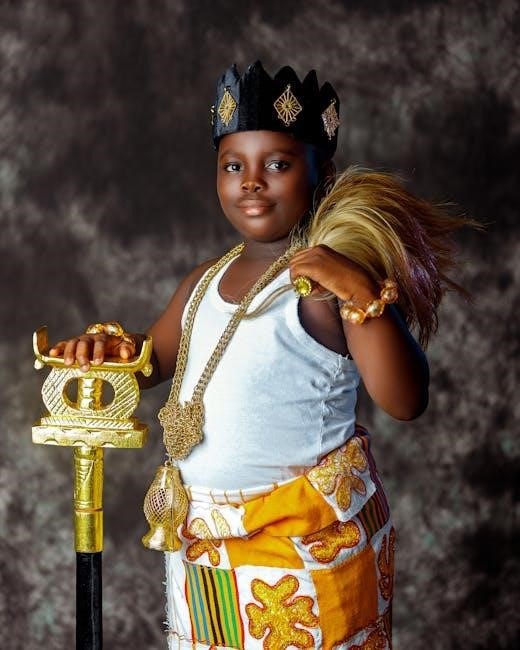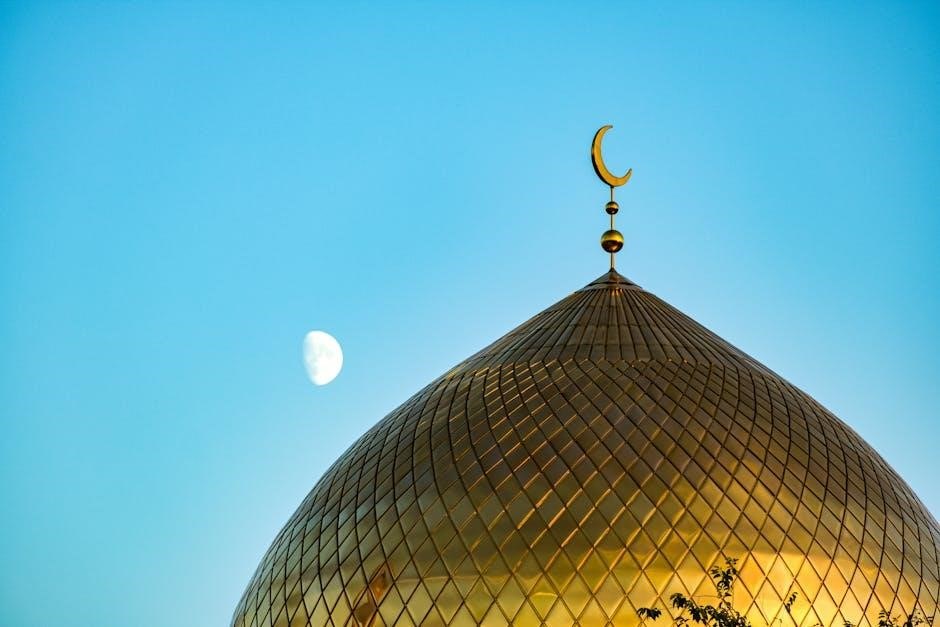narnia prince caspian pdf
Prince Caspian: Overview
“Prince Caspian”, the second published book in “The Chronicles of Narnia”, transports readers back to Narnia, where time has passed differently․
The Pevensie siblings are called upon to help Prince Caspian reclaim his throne from his evil uncle․

Plot Summary of Prince Caspian
The story begins a year after the Pevensie siblings left Narnia, but in Narnia, centuries have passed․ The land is now ruled by the Telmarines, and the magical creatures of old have been driven into hiding․ Prince Caspian, the rightful heir to the throne, is forced to flee when his uncle Miraz plots to kill him․ He escapes into the forest, where he stumbles upon the ancient Narnians, including dwarves, talking animals, and other mythical beings․
Caspian blows the ancient horn of Queen Susan, which magically summons Peter, Susan, Edmund, and Lucy back to Narnia․ Upon their arrival, they discover that their castle, Cair Paravel, is now in ruins․ Together, they join forces with Caspian and the remaining Narnians to fight against Miraz and his Telmarine army․ The battles are fraught with danger, and faith in Aslan is tested as they struggle to restore Narnia to its former glory and rightful ruler․ The climax involves a duel between Peter and Miraz, and ultimately, Aslan’s return brings about the final victory․
Main Characters in Prince Caspian
The main characters include Prince Caspian, the Pevensie siblings (Peter, Susan, Edmund, and Lucy), and Aslan․ Each plays a crucial role in the fight to restore Narnia to its former glory and rightful ruler․
Prince Caspian
Caspian, also known as Caspian X, King of Narnia, Lord of Cair Paravel, and Emperor of The Lone Islands, is a pivotal character․ He is the rightful heir to the Narnian throne, denied his birthright by his uncle, Miraz․ Fleeing for his life, he encounters the old Narnians, creatures of myth and magic, who pledge their allegiance to him․
Caspian represents hope for the restoration of Narnia’s former glory․ He embodies courage and a desire for justice, leading the charge against the tyrannical Miraz; His journey is one of self-discovery, learning to trust in the old ways of Narnia and the power of Aslan․ He rallies a ragtag army to restore the throne․
He is a young man burdened with responsibility, struggling to unite the divided Narnians and reclaim what is rightfully his․ Caspian’s leadership and unwavering belief in the possibility of a better Narnia make him a central figure․
The Pevensie Siblings
Peter, Susan, Edmund, and Lucy Pevensie return to Narnia, finding it vastly changed after centuries have passed in the magical kingdom․ They are no longer the kings and queens who once ruled; instead, they are children again, thrust into a Narnia they barely recognize․
The siblings must adapt to this new reality and rediscover their roles in Narnia’s destiny․ Peter, the High King, grapples with his past authority and the challenges of leading a new battle․ Susan, known for her archery, faces difficult choices․ Edmund, who once betrayed his siblings, seeks redemption through loyalty and wisdom․ Lucy, the youngest, maintains her unwavering faith in Aslan, guiding her siblings through doubt and despair․
Their return is essential to restoring Narnia․ They must come together, remembering their past experiences and embracing their new roles to help Prince Caspian reclaim his throne and bring peace back․
Aslan
Aslan, the great lion and creator of Narnia, remains a central figure in “Prince Caspian”, though his presence is less direct than in “The Lion, the Witch, and the Wardrobe․” He represents the ultimate good and divine power, guiding events and intervening when needed to restore balance and justice to Narnia․
During this time of darkness and oppression under King Miraz, Aslan’s return is prophesied and longed for by the Narnians․ He embodies hope and the promise of liberation․ Lucy is the first to see him, but her siblings struggle to believe, highlighting the theme of faith and the challenges of trusting in what cannot be immediately seen or understood․
Aslan’s eventual reappearance signifies the restoration of Narnia’s true order․ He empowers Prince Caspian to reclaim his rightful place, proving that even in the darkest times, his presence and power endure․
Themes Explored in Prince Caspian
“Prince Caspian” delves into themes of lost innocence, faith, and the struggle between good and evil․ It highlights the challenges of belief in the face of adversity․
Loss of Innocence
In “Prince Caspian”, the theme of loss of innocence is prominent as Narnia has changed drastically since the Pevensies last visit․ The magical creatures are suppressed, and the land is under the rule of the Telmarines․ The Pevensie children, especially Lucy, grapple with the fading magic and the disbelief of others in Aslan․
Caspian himself experiences a loss of innocence as he learns about his family’s history and the true nature of his uncle, Miraz․ The novel reflects the harsh realities of war and political intrigue, contrasting with the idealized memories of Narnia’s past․ The characters are forced to confront a more complex and darker world, marking their transition from childhood to adulthood․ This loss is seen with the fading magic․
Faith and Belief
“Prince Caspian” deeply explores the themes of faith and belief, particularly in the face of doubt and despair․ The Narnians’ dwindling belief in Aslan is a central conflict, reflecting a spiritual crisis in the land․ Lucy Pevensie’s unwavering faith serves as a stark contrast to the skepticism of her siblings, highlighting the importance of trusting in what cannot be seen․
The return of Aslan is not immediate or universally accepted, symbolizing the challenges of maintaining faith during difficult times․ Caspian’s journey also involves a growing belief in the old stories of Narnia, leading him to embrace his role in restoring its former glory․ The novel suggests that true faith requires courage, perseverance, and a willingness to believe even when evidence seems lacking․ This is the test of Lucy and the others․
Good vs․ Evil
The classic theme of good versus evil is prominently displayed in “Prince Caspian”, embodied by the conflict between the rightful heir, Prince Caspian, and his power-hungry uncle, Miraz․ Miraz represents tyranny and oppression, seeking to eradicate the old Narnians and impose his rule through fear and violence․ His actions symbolize the corruption of power and the dangers of unchecked ambition․
In contrast, Caspian, aided by the Pevensie siblings and the remaining Narnians, embodies hope and justice․ The struggle between these forces highlights the importance of standing up against injustice and fighting for what is right․ Aslan’s eventual return and triumph over Miraz reinforce the idea that good ultimately prevails over evil, but not without sacrifice and struggle․ The battle scenes and strategic decisions throughout the book further illustrate the complexities of this conflict․

Adaptations of Prince Caspian
“Prince Caspian” has been adapted into various forms, including a notable film adaptation in 2008․ These adaptations bring the magical world of Narnia to life visually, offering a different perspective on the story․
Film Adaptation (2008)
The 2008 film adaptation of “Prince Caspian”, directed by Andrew Adamson, brought the magical world of Narnia to the big screen․
Starring Ben Barnes as Prince Caspian and featuring the return of the Pevensie siblings, the movie aimed to capture the essence of C․S․ Lewis’s beloved novel․
The film follows the Pevensies’ return to Narnia, where they find that centuries have passed and the land is under the oppressive rule of the Telmarines․
They join forces with Prince Caspian to fight for Narnia’s freedom․
The film featured a darker tone than its predecessor, reflecting the more mature themes of the book․
With stunning visuals and engaging action sequences, the movie provided a new way for audiences to experience the story․
It is available for purchase or rental on platforms like Amazon Video and Apple TV, as well as streaming on Disney Plus․
Differences between the Book and the Movie
The film adaptation of “Prince Caspian”, while visually impressive, takes certain liberties with the source material, leading to some key differences between the book and the movie․
One notable change is the expanded role of certain characters and the addition of new scenes to heighten the drama․
The film portrays a more prominent romantic subplot, which is less emphasized in the book․
Additionally, the battle sequences are often more elaborate and action-packed in the movie to create a more cinematic experience․
Some character motivations and plot points are also altered to streamline the narrative for the screen․
Purists of C․S․ Lewis’s work may find these departures significant․
However, the filmmakers aimed to create an engaging and accessible adaptation for a wider audience, which led to these creative choices․
Despite these differences, the core themes and overall storyline of “Prince Caspian” remain intact in the film․

Availability of “Prince Caspian” in PDF Format
For those seeking a digital copy of C․S․ Lewis’s “Prince Caspian”, the PDF format offers a convenient option․
Numerous websites and online platforms provide access to eBooks, including this beloved Narnia tale․
However, it’s essential to exercise caution and ensure you’re downloading from legitimate sources to avoid copyright infringement and potential malware․
Many authorized eBook retailers, such as Amazon Kindle Store, Apple Books, and Google Play Books, offer the official digital version of “Prince Caspian” for purchase․
Additionally, some libraries may provide access to eBooks through their digital lending services․
Be aware of websites that offer free PDF downloads without proper authorization, as these may be illegal or contain harmful software․
Always prioritize reputable sources when searching for a PDF copy of “Prince Caspian” to ensure a safe and legal reading experience․
Enjoy this magical adventure in a digital format!

Where to Find Legal PDF Copies
Finding a legal PDF copy of “Prince Caspian” requires careful consideration․
Start by checking reputable online bookstores like Amazon Kindle Store, Apple Books, and Barnes & Noble․
These platforms offer authorized digital versions of the book, ensuring you’re supporting the author and publisher․
Another excellent option is to explore your local library’s digital lending services․
Many libraries provide access to eBooks through platforms like OverDrive or Libby, allowing you to borrow “Prince Caspian” in PDF format for a limited time․
Websites such as Project Gutenberg may offer older editions of the book if the copyright has expired, but ensure the version matches your needs․
Avoid downloading from unofficial sources promising free PDFs, as these often violate copyright laws and may contain viruses․
Always look for official publisher websites or authorized retailers to guarantee a safe and legal download of “Prince Caspian” in PDF format․
Happy reading!
